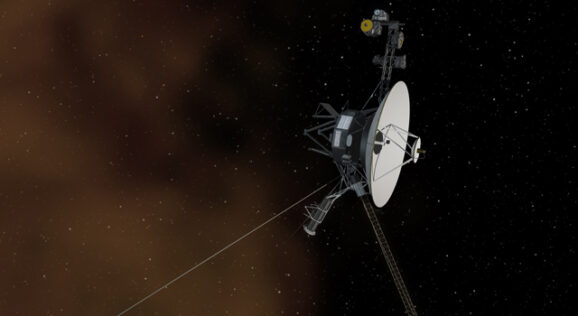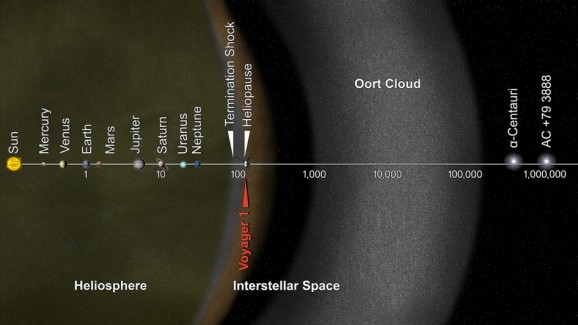Voyager 1 Boldly (And Historically) Goes Into Interstellar Space
This article is more than 2 years old
 Voyager 1 has been journeying through space just longer than I’ve been journeying on Earth — 36 years. Now scientists know for sure that it’s the first man-made craft to exit our solar system and pass into interstellar place, having left the sun some 12 billion miles behind.
Voyager 1 has been journeying through space just longer than I’ve been journeying on Earth — 36 years. Now scientists know for sure that it’s the first man-made craft to exit our solar system and pass into interstellar place, having left the sun some 12 billion miles behind.
For the past year, Voyager 1 has been traversing “star stuff” — ionized gas otherwise known as plasma. It’s currently free of the sun’s gravitational pull and out of the solar system, but not free of all effects of the sun. It no longer has to use sunscreen, though.
The Voyager team is busy analyzing new data sent from Voyager 1 about the plasma it recently passed through and the space it’s currently traversing. Everything it registers is completely new, so scientists have a lot of work to do in terms of making sense of the information coming in, as well as figuring out what the new questions and gaps are. Like impatient kids in the back seat during a long road trip, scientists have been waiting in anticipation, asking “Are we there yet?” Finally, we are.

It’s not easy for scientists to know exactly where Voyager 1 is — it’s not as though they’ve got interstellar space mapped on their GPS systems. Part of the challenge recently is that Voyager 1 doesn’t have a functional plasma sensor, so locating it was challenging. Scientists caught a cosmic break there — in March 2012, there was a coronal mass ejection (CME), an eruption of solar wind that releases into space. Thirteen months later, evidence of the CME reached Voyager 1, vibrating the plasma around the craft. Scientists were able to determine the plasma’s density, and were able to calculate that the craft had passed through the heliopause — the space between solar plasma and interstellar plasma. The best guess of the Voyager team is that the craft entered interstellar space just over a year ago, on or around August 25, 2012.
Scientists will continue to receive data from Voyager 1, though the signals emitted are very dim — akin to the power of a refrigerator light, according to NASA, and much weaker than that by the time it makes it to Earth. Even traveling at light speed, a signal takes roughly 17 hours to get to Earth. “We expect the fields and particles science instruments on Voyager will continue to send back data through at least 2020. We can’t wait to see what the Voyager instruments show us next about deep space,” says Voyager project manager Suzanne Dodd.
Voyager 2, its twin, was launched 16 days earlier in 1977 and has been in continuous operation for longer than any other spacecraft. These veteran spacecraft owe their longevity to nuclear batteries, among other things. Voyager 2 is the slow twin, though — it’s roughly 9.5 billion miles from Earth, and scientists aren’t exactly sure when it’ll venture into interstellar space, but they don’t think it’ll be too long. Someday, they may go beyond the Rim to party with the First Ones.












